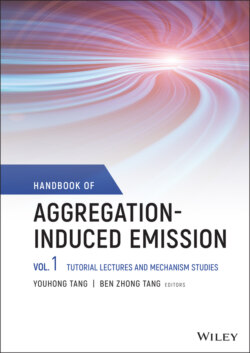Читать книгу Handbook of Aggregation-Induced Emission, Volume 1 - Группа авторов - Страница 46
2.6 Summary and Outlook
ОглавлениеIn this chapter, the detailed AIE mechanism is discussed at the molecular level by combining multiscale modeling with TVCF formalism based on FGR using the homebuilt MOMAP program package. The solvent effect and aggregate effect were considered by using PCM and QM/MM models, respectively. We proposed that the restriction of the nonradiative decay channel by compact molecular packing and electrostatic interaction in aggregate state turns the fluorescence on. The restriction of the nonradiative decay channel occurs by the electron–vibration decoupling and the vibration–vibration demixing among various kinds of normal modes, such as rotating, stretching, bending, flipping, and twisting vibrations. To validate the proposed AIE mechanism, we build the relationship between the calculated photophysical parameters and the experimentally visualizable signals. (i) The reorganization energy is comparable with the Stokes shift between the absorption and emission spectra, the decrease of Stokes shift induced by the decreasing reorganization energy, which causes blue‐shifted emission upon aggregation. (ii) The reorganization energy of each normal mode is proportional to the ratio of the RRS intensity and frequency of the corresponding mode. (iii) The DRE, which plays an important role in the nonradiative decay process in flexible systems, can be validated by IE. (iv) The fluorescence efficiency is independent of the size of the aggregate, and the fluorescence intensity can be quantified by the aggregate size because of the linear relationship between them. (v) The pressure can further weaken the electron–vibration coupling until reaching a certain value and gradually enhance the solid‐phase fluorescence to a maximum. The experiments could be well reproduced by theoretical calculation quantitatively. Combining the proposed AIE mechanism, the deep insights into the different bioimaging behaviors of two representative AIEgens with similar structures are unraveled. Based on this, we proposed the rational design principles for AIE probes to selectively target the lipid membrane or mitochondria, which is confirmed by the cell imaging study in experiments.
Figure 2.10 (a) The QM/MM model of TTVP in lipid membrane. (b, c) Calculated NTOs for TTVP at S1 states in both lipid membrane and dilute THF solution. (d, e) Superposition of optimized structures at both S0 and S1 states for TTVP in both lipid membrane and dilute THF solution. Calculated (f) total reorganization energies and (g) fluorescence emission spectrum of TTVP in both lipid membrane and dilute THF solution.
Source: Reproduced from Ref. [77]. Copyright 2019 The Royal Society of Chemistry.
Accurately describing the structure of excited state and decay processes is still a long‐term challenge computationally because the electron–electron correlation and electron–vibration coupling are required to be involved [78]. The anharmonic effect and extremely strong vibronic coupling beyond the Franck–Condon region are not considered in the current theoretical approaches, although it is found that the excitonic coupling has very minor effect on the nonradiative decay rate with only 12–33% enhancement for typical AIEgens [79, 80]. The effect of the intermolecular excitonic coupling should be taken into account, as well as the intermolecular charge transfer and excimer, for more compact molecular packing with short distance or strong π–π stacking. In addition, polarizable force field needs to be involved in the QM/MM protocol to consider the electron‐density change of the QM molecule in the excited state. All these are being actively pursued.
